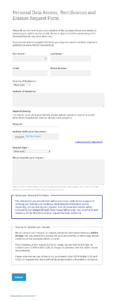Utilizing a pre-defined structure streamlines the process for both the requester and the organization. It reduces ambiguity, ensuring requests are clear and actionable, thus minimizing processing time and potential misunderstandings. This contributes to greater transparency and efficiency in managing data subject rights.
Understanding the components and utilization of such forms is critical for organizations seeking to uphold data protection principles and maintain legal compliance. The following sections delve deeper into the practical aspects and implications.
Key Components of a Data Subject Access Request Form
Effective data subject access request forms contain specific elements to ensure clarity and completeness. These components facilitate efficient processing and demonstrate organizational commitment to data protection rights.
1: Requester Identification: Clear fields for the requester’s full name, contact details, and preferred communication method ensure accurate identification and facilitate timely responses.
2: Specific Information Sought: Providing space for the requester to specify the information sought helps organizations pinpoint relevant data and avoids unnecessary disclosure of unrelated information.
3: Date Range: If applicable, a field for specifying a date range for the requested information can further refine the search and limit the scope of the request.
4: Proof of Identity: Requiring appropriate proof of identity protects against fraudulent requests and ensures data is disclosed only to authorized individuals.
5: Authorization (if applicable): If the request is submitted on behalf of another individual, a section for providing documented authorization ensures legitimacy.
6: Signature and Date: Including space for the requester’s signature and the date of the request provides a record of formal submission.
These elements ensure requests are comprehensive, easily processed, and compliant with data protection regulations. A well-structured form benefits both the requester and the organization by streamlining communication and facilitating efficient data access.
How to Create a GDPR Data Subject Access Request Form
Creating a robust and compliant data subject access request form requires careful consideration of key elements to ensure clarity, efficiency, and legal compliance. The following steps outline the process:
1: Establish Clear Identification Fields: Begin by incorporating fields for the requester’s full name, address, email address, phone number, and preferred method of communication. This facilitates accurate identification and efficient response delivery.
2: Provide Space for Specific Information Requests: Include a dedicated section where requesters can detail the specific information they seek. This allows organizations to precisely target data retrieval and avoid unnecessary disclosure of unrelated information. Consider providing examples of common requests for guidance.
3: Incorporate a Date Range Field (Optional): Depending on the nature of the data processed, a field for specifying a relevant date range can be beneficial. This further refines the request and streamlines the retrieval process.
4: Implement a Proof of Identity Section: Require appropriate documentation to verify the requester’s identity. This protects against fraudulent requests and ensures compliance with data protection principles. Clearly outline acceptable forms of identification.
5: Include an Authorization Section (If Applicable): If requests can be submitted on behalf of another individual, incorporate a dedicated section for providing documented authorization. This safeguards against unauthorized access to personal data.
6: Add a Declaration and Signature Field: Include a declaration for the requester to affirm the accuracy of the information provided and a space for signature and date. This formalizes the request and provides a record of submission.
7: Provide Clear Instructions and Contact Information: Include clear instructions on how to complete and submit the form, along with contact details for inquiries or assistance. This ensures ease of use and facilitates communication.
8: Make the Form Easily Accessible: Ensure the form is easily accessible through various channels, such as the organization’s website, physical locations, and upon request. Promote awareness of the form’s availability.
A well-designed form facilitates the exercise of data subject rights under the GDPR. By incorporating these elements, organizations can streamline the process, improve efficiency, and demonstrate commitment to data protection principles. This fosters trust and strengthens the organization’s overall data governance framework.
Standardized forms for requesting access to personal data under the GDPR serve as a crucial component of a robust data protection framework. These structured templates facilitate clear communication between data subjects and organizations, ensuring requests are comprehensive, unambiguous, and easily processed. Key elements such as clear identification fields, specific information requests, and provisions for identity verification contribute to efficient and secure data handling. Accessibility of these forms underscores organizational commitment to transparency and compliance.
Effective implementation of data subject access request procedures, facilitated by well-designed templates, is essential for maintaining compliance with evolving data protection regulations and fostering trust with individuals. Organizations must prioritize the development and accessibility of these tools to ensure the continued protection of individual rights and the responsible handling of personal information in the digital age.

